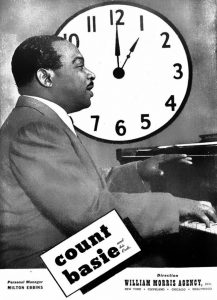
“One O’Clock Jump” was composed by Count Basie in 1937, in collaboration with saxophonist Buster Smith and arranger Eddie Durham. Basie had been a member of a band led by pianist Benny Moten for several years. When Moten died in 1935, Basie took over the band and developed it as his own. The first theme song of the Count Basie Orchestra was “Moten Blues.” This was followed for a short period of time by a slow number rendered by saxophonist Herschel Evans titled “Blue and Sentimental,” which would then replaced by “One O’Clock Jump” after its immediate success.
Though it was credited to Basie, “One O’Clock Jump” is a composition based on a 12-bar blues progression that foregrounds a succession of soloists over riff backings. Catherine Tackley writes that according to Gunther Schuller, this riff is derived from a 1929 Chocolate Dandies recording of a number called “Six or Seven Times” that was “worked into a head arrangement by Count Basie and his band while they were still in Kansas.”
Though credited to Basie, “One O’Clock Jump” owed a lot to individual members. Their original 1937 recording of the song, for instance, featured such stellar musicians as saxophonists Evans and Lester Young, trumpeter Buck Clayton, bassist Walter Page, and Basie himself on piano. The original title of the song wad “Blue Balls.” Deeming the title inappropriate for radio, when asked about the title during a recording session, Count Basie allegedly looked at the clock and responded with “One O’Clock Jump.”
Thanks to the success of such dance tunes as “One O’Clock Jump” and “Jumping at the Woodside,” the Count Basie Orchestra became one of the most popular bands of the swing era and, for a while, Basie became known as the “Jump King of Swing.” In fact, Basie’s popularity was such that it rivaled that of bandleader and clarinetist Benny Goodman. The Benny Goodman Orchestra accepted the challenge and responded by recording their own version of the song in 1938, which became a hit for them and that group’s first million-selling record.









